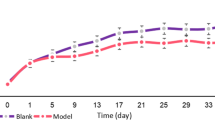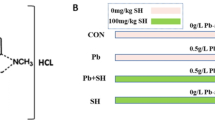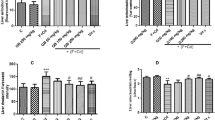Abstract
Exposure to cadmium (Cd) and lead (Pb) can induce liver damage. However, the effects of the combined exposure to Cd and Pb on liver function have not been fully clarified. In the present study, we investigated the liver function in rats co-exposed to Cd and Pb. A total of 24 female SD rats were divided into 4 groups as follows: control group (DDW), Cd group (50 mg/l Cd), Pb group (300 mg/l Pb), Pb + Cd group (300 mg/l + 50 mg/l Cd). Following 12 weeks of continuous exposure, the results showed a large accumulation of Cd and Pb in the liver. The Liver weight and Liver coefficient were decreased, as well as liver structure and function was destroyed. In addition, Pb + Cd group exhibited additional pathological alterations. Moreover, the indices of oxidative stress and related trace elements were detected following treatment. The results showed that the single treatment of Pb or Cd and the combined Cd and Pb treatment could upregulate the contents of antioxidant enzymes and related trace elements. We further examined the expression levels of autophagy-related proteins and mRNAs, and we found that the single treatment of Pb or Cd and the combined Cd and Pb treatment could upregulate the expression of levels of autophagy-related proteins and mRNAs (Atg5, Atg7, Beclin-1, p62, and LC3). Transmission electron microscopy revealed the presence of autophagosomes in the exposed groups. All the results indicated that Cd and Pb may affect the level of oxidative stress and autophagy in hepatocytes, whereas the combination of Cd and Pb showed a tendency of escalation compared with the single treatment group.





Similar content being viewed by others
References
Kirillova AV, Danilushkina AA, Irisov DS, Bruslik NL, Fakhrullin RF, Zakharov YA, Bukhmin VS, Yarullina DR (2017) Assessment of resistance and bioremediation ability of lactobacillus strains to lead and cadmium 2017(4):1–7
Shimada H, Yasutake A, Hirashima T, Takamure Y, Kitano T, Waalkes MP, Imamura Y (2008) Strain difference of cadmium accumulation by liver slices of inbred Wistar-Imamichi and Fischer 344 rats. Toxicol in Vitro 22(2):338–343
Hormozi M, Mirzaei R, Nakhaee A, Izadi S, Dehghan Haghighi J (2018) The biochemical effects of occupational exposure to lead and cadmium on markers of oxidative stress and antioxidant enzymes activity in the blood of glazers in tile industry. Toxicol Ind Health 34(7):459–467. https://doi.org/10.1177/0748233718769526
Wang T, Feng W, Kuang D, Deng Q, Zhang W, Wang S, He M, Zhang X, Wu T, Guo H (2015) The effects of heavy metals and their interactions with polycyclic aromatic hydrocarbons on the oxidative stress among coke-oven workers. Environ Res 140:405–413. https://doi.org/10.1016/j.envres.2015.04.013
Xu X, Liao W, Lin Y, Dai Y, Shi Z, Huo X (2018) Blood concentrations of lead, cadmium, mercury and their association with biomarkers of DNA oxidative damage in preschool children living in an e-waste recycling area. Environ Geochem Health 40(4):1481–1494. https://doi.org/10.1007/s10653-017-9997-3
Li T, Yu H, Song Y, Zhang R, Ge M (2019) Protective effects of Ganoderma triterpenoids on cadmium-induced oxidative stress and inflammatory injury in chicken livers. J Trace Elem Med Biol
Cao Z, Fang Y, Lu Y, Tan D, Du C, Li Y, Ma Q, Yu J, Chen M, Zhou C (2017) Melatonin alleviates cadmium-induced liver injury by inhibiting the TXNIP-NLRP3 inflammasome. J Pineal Res 62(3)
Flora G, Gupta D, Tiwari A (2012) Toxicity of lead: a review with recent updates. Interdiscip Toxicol 5(2):47–58
Fukase Y, Tsugami H, Nakamura Y, Ohba K, Ohta H (2014) [The role of metallothionein and metal transporter on cadmium transport from mother to fetus]. Yakugaku Zasshi. J Pharm Soc Jpn 134(7):801–804
Matović V, Buha A, Ðukić-Ćosić D, Bulat Z (2015) Insight into the oxidative stress induced by lead and/or cadmium in blood, liver and kidneys. Food Chem Toxicol 78:130–140
Fung TS, Torres J, Ding XL (2015) The emerging roles of viroporins in ER stress response and autophagy induction during virus infection. Viruses 7(6):2834–2857
Rocchi A, He C (2017) Activating autophagy by aerobic exercise in mice. J Vis Exp 2017(120). https://doi.org/10.3791/55099
Moshi S, Yun C, Guohua G, Elizabeth M, Rabinovitch PS, Dorn GW (2014) Super-suppression of mitochondrial reactive oxygen species signaling impairs compensatory autophagy in primary mitophagic cardiomyopathy. Circ Res 115(3):348–353
Kim J, Kundu M, Viollet B, Guan K-L AMPK AMPK and mTOR regulate autophagy through direct phosphorylation of Ulk1. Nat Cell Biol 13(2):132–141
Chu BX, Fan RF, Lin SQ, Yang DB, Wang ZY, Wang L (2018) Interplay between autophagy and apoptosis in lead(II)-induced cytotoxicity of primary rat proximal tubular cells. J Inorg Biochem 182:184
Kato H, Katoh R, Kitamura M (2013) Dual regulation of cadmium-induced apoptosis by mTORC1 through selective induction of IRE1 branches in unfolded protein response. PLoS One 8(5):e64344
Fleming A, Noda T, Yoshimori T, Rubinsztein DC (2011) Chemical modulators of autophagy as biological probes and potential therapeutics. Nat Chem Biol 7(1):9–17
Chen R, Wang H, Liang B, Liu G, Tang M, Jia R, Fan X, Jing W, Zhou X, Wang H (2016) Downregulation of ASPP2 improves hepatocellular carcinoma cells survival via promoting BECN1-dependent autophagy initiation. Cell Death Dis 7(12):e2512
Zhou H, Yuan M, Yu Q, Zhou X, Min W, Gao D (2016) Autophagy regulation and its role in gastric cancer and colorectal cancer. Cancer Biomarkers 17(1):1–10
Zou H, Liu X, Han T, Hu D, Wang Y, Yuan Y, Gu J, Bian J, Zhu J, Liu ZP (2015) Salidroside protects against cadmium-induced hepatotoxicity in rats via GJIC and MAPK pathways. PLoS One 10(6):e0129788. https://doi.org/10.1371/journal.pone.0129788
Zou H, Zhuo L, Han T, Hu D, Yang X, Wang Y, Yuan Y, Gu J, Bian J, Liu X, Liu Z (2015) Autophagy and gap junctional intercellular communication inhibition are involved in cadmium-induced apoptosis in rat liver cells. Biochem Biophys Res Commun 459(4):713–719. https://doi.org/10.1016/j.bbrc.2015.03.027
Lin X, Gu Y, Zhou Q, Mao G, Zou B, Zhao J (2016) Combined toxicity of heavy metal mixtures in liver cells. J Appl Toxicol:n/a-n/a
Valko M, Morris H, Cronin MT (2005) Metals, toxicity and oxidative stress. Curr Med Chem 12(10):1161–1208
Badary DM (2017) Folic acid protects against lead acetate-induced hepatotoxicity by decreasing NF-κB, IL-1β production and lipid peroxidation mediated cell injury. Pathophysiology 24(1):39–44
Yuan G, Dai S, Yin Z, Lu H, Jia R, Xu J, Song X, Li L, Shu Y, Zhao X (2014) Toxicological assessment of combined lead and cadmium: acute and sub-chronic toxicity study in rats. Food Chem Toxicol 65:260–268. https://doi.org/10.1016/j.fct.2013.12.041
Markiewicz-Górka I, Januszewska L, Michalak A, Prokopowicz A, Januszewska E, Pawlas N, Pawlas K (2015) Effects of chronic exposure to lead, cadmium, and manganese mixtures on oxidative stress in rat liver and heart. Arch Ind Hyg Toxicol 66(1):51–62
Andjelkovic M, Buha Djordjevic A, Antonijevic E, Antonijevic B, Stanic M, Kotur-Stevuljevic J, Spasojevic-Kalimanovska V, Jovanovic M, Boricic N, Wallace D, Bulat Z (2019) Toxic effect of acute cadmium and Lead exposure in rat blood, liver, and kidney. Int J Environ Res Public Health 16(2):274
Luo T, Liu G, Long M, Yang J, Song R, Wang Y, Yuan Y, Bian J, Liu X, Gu J (2016) Treatment of cadmium-induced renal oxidative damage in rats by administration of alpha-lipoic acid. Environ Sci Pollut Res:1–13
Al-Attar AM (2011) Vitamin E attenuates liver injury induced by exposure to lead, mercury, cadmium and copper in albino mice. Saudi J Biol Sci 18(4):395–401. https://doi.org/10.1016/j.sjbs.2011.07.004
Eşrefogğlu M, Gül M, Dogřu MI, Dogřu A, Yürekli M (2007) Adrenomedullin fails to reduce cadmium-induced oxidative damage in rat liver. Exp Toxicol Pathol 58(5):367–374. https://doi.org/10.1016/j.etp.2006.11.006
Mahaffey KR, Fowler BA (1977) Effects of concurrent administration of lead, cadmium, and arsenic in the rat. Environ Health Perspect 19:165–171. https://doi.org/10.1289/ehp.7719165
Huo J, Dong A, Wang Y, Lee S, Ma C, Wang L (2017) Cadmium induces histopathological injuries and ultrastructural changes in the liver of freshwater turtle (Chinemys reevesii). Chemosphere 186:459–465. https://doi.org/10.1016/j.chemosphere.2017.08.029
Pineau A, Fauconneau B, Plouzeau E, Fernandez B, Quellard N, Levillain P, Guillard O (2017) Ultrastructural study of liver and lead tissue concentrations in young mallard ducks (Anas platyrhynchos) after ingestion of single lead shot. J Toxic Environ Health A 80(3):188–195. https://doi.org/10.1080/15287394.2017.1279093
Morales CR, Pedrozo Z, Lavandero S, Hill JA (2014) Oxidative stress and autophagy in cardiovascular homeostasis. Antioxid Redox Signal 20(3):507–518
Long M, Liu Y, Cao Y, Wang N, Dang M, He J (2016) Proanthocyanidins attenuation of chronic Lead-induced liver oxidative damage in Kunming mice via the Nrf2/ARE pathway. Nutrients 8(10):656
Liu J, Qu WM (2009) Role of oxidative stress in cadmium toxicity and carcinogenesis. Toxicol Appl Pharmacol 238(3):209–214
Jomova K, Valko M (2011) Advances in metal-induced oxidative stress and human disease. Tosicology 283(2–3):65–87
Ognjanovic B, Markovic S, Pavlovic S, Zikic R, As SZ (2008) Effect of chronic cadmium exposure on antioxidant defense system in some tissues of rats: protective effect of selenium. Physiol Res 57(3):403–411
Renugadevi J, Prabu SM (2008) Naringenin protects against cadmium-induced oxidative renal dysfunction in rats. Toxicology 256(1–2):128–134
Mijaljica D, Prescott M, Devenish RJ (2010) Autophagy in disease. Methods Mol Biol 648:79–92
Li R, Zhang L, Shi Q, Guo Y, Zhang W, Zhou B (2018) A protective role for autophagy in TDCIPP-induced developmental neurotoxicity in zebrafish larvae. Aquat Toxicol 199:46–54
Xin-Yu W, Heng Y, Min-Ge W, Du-Bao Y, Zhen-Yong W, Lin W (2017) Trehalose protects against cadmium-induced cytotoxicity in primary rat proximal tubular cells via inhibiting apoptosis and restoring autophagic flux. Cell Death Dis 8(10):e3099
He S, Yaung J, Kim YH, Barron E, Ryan SJ, Hinton DR (2008) Endoplasmic reticulum stress induced by oxidative stress in retinal pigment epithelial cells. Graefes Arch Clin Exp Ophthalmol 246(5):677–683
Huang H, Wang Y, An Y, Jiao W, Xu Y, Han Q, Teng X, Teng X (2019) Selenium alleviates oxidative stress and autophagy in lead-treated chicken testes. Theriogenology
Bizarro P, Acevedo S, Niño-Cabrera G, Mussali-Galante P, Pasos F, Avila-Costa MR, Fortoul TI (2003) Ultrastructural modifications in the mitochondrion of mouse Sertoli cells after inhalation of lead, cadmium or lead–cadmium mixture. Reprod Toxicol 17(5):561–566
Hao L, Li M, Ying Z, JianSen D, ZongPing L (2009) Morphological changes of cerebral cortical neurons by lead or/and cadmium in neonatal rat in vitro culture. 2:251
Dai S, Yin Z, Yuan G, Lu H, Jia R, Xu J, Song X, Li L, Shu Y, Liang X (2013) Quantification of metallothionein on the liver and kidney of rats by subchronic lead and cadmium in combination. 36(3):1207–1216
Funding
This work was supported by the National Key Research and Development Program of China [No.2016YFD0501208], the National Natural Science Foundation of China [Nos. 31702305, 31872533, 31772808, 31802260, and 31672620], the Natural Science Foundation of Jiangsu Province [No. BK20160458], the China Postdoctoral Science Foundation [2016 M601900], the Jiangsu Overseas Research & Training Program for University Prominent Young & Middle-aged Teachers and Presidents and a project funded by the Priority Academic Program Development of Jiangsu Higher Education Institutions (PAPD).
Author information
Authors and Affiliations
Corresponding author
Ethics declarations
Conflict of Interest
The authors declare that they have no conflict of interest.
Additional information
Publisher’s Note
Springer Nature remains neutral with regard to jurisdictional claims in published maps and institutional affiliations.
Rights and permissions
About this article
Cite this article
Zou, H., Sun, J., Wu, B. et al. Effects of Cadmium and/or Lead on Autophagy and Liver Injury in Rats. Biol Trace Elem Res 198, 206–215 (2020). https://doi.org/10.1007/s12011-020-02045-7
Received:
Accepted:
Published:
Issue Date:
DOI: https://doi.org/10.1007/s12011-020-02045-7




